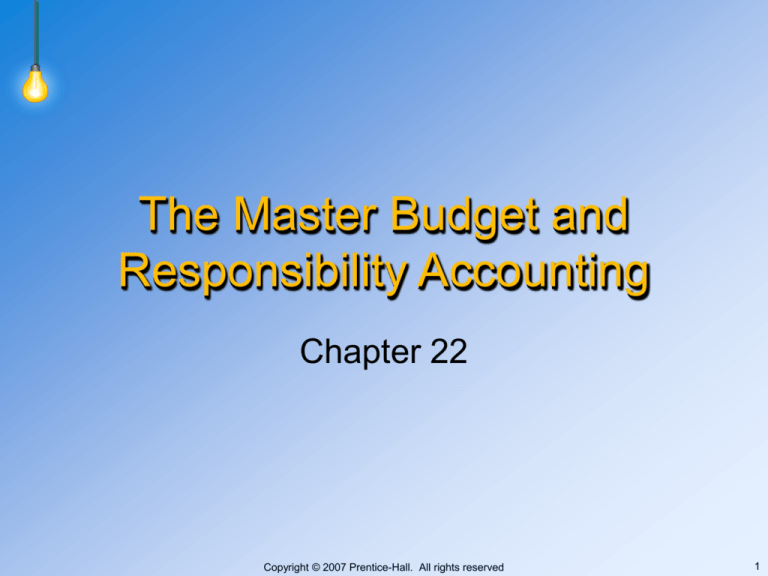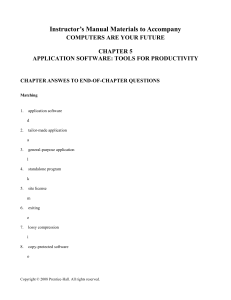
The Master Budget and
Responsibility Accounting
Chapter 22
Copyright © 2007 Prentice-Hall. All rights reserved
1
A budget is a plan that covers a
specific period of time. It helps
management determine how best to
use its resources – both materials
and manpower. Management
estimates future cost and revenues
Objective 1
Learn how to use a budget
Copyright © 2007 Prentice-Hall. All rights reserved
2
Benefits of Budgeting
• Planning
• Coordination and communication
• Benchmarking
Copyright © 2007 Prentice-Hall. All rights reserved
3
Master Budget
• Operating budget - planned revenues and
expenses
• Capital expenditures budget - plan for
purchasing PP&E
• Financial budget - cash budget and
budgeted balance sheet
Copyright © 2007 Prentice-Hall. All rights reserved
4
Master Budget
Operating Budget
Sales Budget
Purchases & Cost of
Goods Sold Budget
The master budget is the financial
Operating
planExpenses
for the entireBudget
organization
The budgets on this slide represent
the operating budget
.
Budgeted Income Statement
Copyright © 2007 Prentice-Hall. All rights reserved
5
Master Budget
Budgeted
Income Statement
Capital
Expenditures
Budget
Cash
Budget
Copyright © 2007 Prentice-Hall. All rights reserved
Budgeted
Balance
Sheet
6
Objective 2
Prepare an operating budget
Copyright © 2007 Prentice-Hall. All rights reserved
7
Sales Budget
• Plan for sales revenues in a future period
• Budgeted sales revenue = sale price per
unit x expected number of units to be sold
Copyright © 2007 Prentice-Hall. All rights reserved
8
E22-8
Waterking
Sales Budget
March
April
Cash sales(80%) $32,000 $40,000
Credit sales(20%)
8,000
10,000
Total sales(100%) $40,000 $50,000
Copyright © 2007 Prentice-Hall. All rights reserved
Total
$90,000
9
Inventory, Purchases, and Cost of
Goods Sold Budget
The only element that is not known or can not be
computed is purchases. Rearrange the equation to
solve for Purchases
Cost of goods sold =
Beginning inventory + Purchases– Ending inventory
Compute
Known
Unknown
Compute
Once you know how much is predicted to be sold, you
Cost ofyougoods
+
can Purchases
plan how much=inventory
need tosold
purchase.
Ending the
inventory–
Remember
equation toBeginning
compute cost inventory
of goods
sold
Copyright © 2007 Prentice-Hall. All rights reserved
10
E22-14
Purchases for first quarter:
Beginning inventory is given = $19,000
Cost of goods sold = Sales x 60% = $60,000
Ending inventory = $20,000 + (10% x (60% x
$150,000) = $29,000
Purchases = Cost of goods sold +
Ending inventory– Beginning inventory
Purchases for first quarter =
$60,000 + 29,000 – 19,000 = $70,000
Copyright © 2007 Prentice-Hall. All rights reserved
11
E22-14
Purchases for second quarter:
Beginning inventory is given = $29,000
Cost of goods sold = Sales x 60% = $90,000
Ending inventory = $20,000 + (10% x (60% x
$125,000) = $27,500
Purchases = Cost of goods sold +
Ending inventory– Beginning inventory
Purchases for second quarter =
$90,000 + 27,500 – 29,000 = $88,500
Copyright © 2007 Prentice-Hall. All rights reserved
12
E22-14
Purchases for third quarter:
Beginning inventory is given = $27,500
Cost of goods sold = Sales x 60% = $75,000
Ending inventory = $20,000 + (10% x (60% x
$200,000) = $32,000
Purchases = Cost of goods sold +
Ending inventory– Beginning inventory
Purchases for third quarter =
$75,000 + 32,000 – 27,500 = $79,500
Copyright © 2007 Prentice-Hall. All rights reserved
13
Inventory, Purchases & Cost of
Goods Sold Budget
Quarter
Cost of goods sold
+Desired ending inventory
=Total required
-Beginning inventory
=Purchases
1
$60,000
29,000
$89,000
19,000
$70,000
2
$90,000
27,500
$117,50
29,000
$88,500
3
$75,000
32,000
$107,000
27,500
$79,500
Total cost of goods sold = $225,000
Copyright © 2007 Prentice-Hall. All rights reserved
14
P22-28B
Total sales
Sales Budget
May
June
$42,900 $43,900
Copyright © 2007 Prentice-Hall. All rights reserved
Total
$86,800
15
P22-28B
Cost of Goods Sold Schedule
Beginning inventory
+Purchases
=Goods available for sale
-Ending inventory
=Cost of goods sold
May
$14,000
21,500
$35,500
20,000
$15,500
Copyright © 2007 Prentice-Hall. All rights reserved
June
$20,000
22,000
$42,000
19,600
$22,400
16
P22-28B
Operating Expense Budget
April
Salary, fixed amount
$4,000
Commission
1,700
Total
$5,700
Rent expense
3,000
Depreciation expense
600
Insurance expense
200
Total
$9,500
Copyright © 2007 Prentice-Hall. All rights reserved
May
$4,000
1,800
$5,800
3,000
600
200
$9,600
17
Budgeted Income Statement
Omaha Office Supply Co.
Budgeted Income Statements
May and June 2008
May
Sales revenue
$42,900
Cost of goods sold*
15,500
Gross profit
$27,400
Operating expenses*
9,500
Operating income
$17,900
June
$43,900
22,400
$21,500
9,600
$11,900
*see separate schedules
Copyright © 2007 Prentice-Hall. All rights reserved
18
Objective 3
Prepare a financial budget
Copyright © 2007 Prentice-Hall. All rights reserved
19
Financial Budget
• Cash budget
• Budgeted balance sheet
Copyright © 2007 Prentice-Hall. All rights reserved
20
Cash Budget
• Cash receipts and cash payments for a
future period
• Cash receipts
– Collections from customers
– Receipts from sale of long-term assets
– Receipts from borrowing
– Receipts from owners
Copyright © 2007 Prentice-Hall. All rights reserved
21
Cash Budget
• Cash payments
– For inventory purchases
– For operating expenses
– Purchase long-term assets
– Payment on loans
– Payment to owners
Copyright © 2007 Prentice-Hall. All rights reserved
22
Cash Collections from Customers –
S22-8
March
$32,000
Cash sales
Collections of last
month’s credit sales
9,000
Total
$41,000
April
Total
$40,000 $72,000
6,400* 15,400
$46,400 $87,400
* March’s sales on account = March sales x 20%
Copyright © 2007 Prentice-Hall. All rights reserved
23
Cash Payments for Purchases –
S22-9
May
Payment of last
month’s purchases
Payment of this
month’s purchases
Total
June
Total
$8,000 $10,000 $18,000
15,000 18,000 33,000
$23,000 $28,000 $51,000
Cash payments for operating expenses are also part
of the cash budget….remember to include only cash
expenses. Depreciation expense is a noncash
expense, so do not include it
Copyright © 2007 Prentice-Hall. All rights reserved
24
Cash Budget
Companies have a desired minimum balance in cash
to keep operations moving smoothly. If cash falls
below the minimum balance, the company will have to
Beginning cash balance
borrow some money
+ Cash receipts
= Cash available
- Cash payments (for inventory, operating
expenses, purchase of long-term assets)
= Ending balance before financing
- Minimum balance
= Excess (deficiency)
Copyright © 2007 Prentice-Hall. All rights reserved
25
Cash Budget
Financing
Borrow
Principal payments
Interest expense
Total effects of financing
Ending cash balance
Copyright © 2007 Prentice-Hall. All rights reserved
26
E22-17
Cash receipts
Jan
Cash collections from credit
customers
Receipt from note receivable
Total
Feb
$11,000 $15,000
6,000
$17,000 $15,000
Copyright © 2007 Prentice-Hall. All rights reserved
27
E22-17
Cash payments
Purchases of inventory
Operating expenses
Total
Jan
Feb
$13,000 $13,900
3,000
3,000
$16,000 $16,900
Copyright © 2007 Prentice-Hall. All rights reserved
28
E22-17
Jan
Feb
Beginning cash balance
$10,500 $11,500
+ Cash receipts
17,000 15,000
= Cash available
$27,500 $26,500
- Cash payments
16,000 16,900
= Ending balance before financing $11,500 $9,600
- Minimum balance
10,000 10,000
= Excess (deficiency)
$1,500
$(400)
Total effects of financing
1,000
Ending cash balance
$11,500 $10,600
Copyright © 2007 Prentice-Hall. All rights reserved
29
Feb 28
balance
Cash
A/R
11,400
5,150
Sales on
credit
Invent
Equip.
Accum.
Depr
17,720
34,800
(29,870)
E22-19
10,500
28,700
12,200
Cost of
goods sold
12,200
(7,320)
(7,320)
Depreciation
expense
(600)
Operating
expenses
(5,000)
Collections
on account
14,300
Payment for
inventory
(4,600)
Payments on
account
(8,200)
Mar 31
balance
A/P
Owner
Equity
7,900
(600)
(5,000)
(14,300)
4,600
(8,200)
3,050
15,000
34,800
Copyright © 2007 Prentice-Hall. All rights reserved
( 30,470)
2,300
27,980
30
Budgeted Balance Sheet
Oleanders
Budgeted Balance Sheet
March 31, 2008
ASSETS
Current Assets:
Cash
Accounts receivable
Inventory
Plant assets:
Furniture and fixtures
Accumulated depreciation
Total assets
Copyright © 2007 Prentice-Hall. All rights reserved
$ 7,900
3,050
15,000 $25,950
34,800
(30,470)
4,330
$30,280
31
Budgeted Balance Sheet
Oleanders
Budgeted Balance Sheet
March 31, 2008 (continued)
LIABILITIES
Current liabilities:
Accounts payable
$ 2,300
OWNERS' EQUITY
Owners' equity
Total liabilities and owners' equity
27,980
$30,280
Copyright © 2007 Prentice-Hall. All rights reserved
32
Budgeting and Sensitivity
Analysis
• Helps managers plan for different courses
of action
• Use of technology and budget software
Copyright © 2007 Prentice-Hall. All rights reserved
33
Objective 4
Prepare performance reports for
responsibility centers
Copyright © 2007 Prentice-Hall. All rights reserved
34
Responsibility Accounting
• System for evaluating performance of
managers and activities they supervise
• Responsibility center - part, segment, or
subunit of an organization whose manager
is accountable for its activities
Copyright © 2007 Prentice-Hall. All rights reserved
35
Responsibility Center
• Cost center – reports costs only
• Revenue center – reports revenues only
• Profit center - reports revenues, expenses,
and net income or loss
• Investment center - reports revenues,
expenses, income or loss, and investment
used
Copyright © 2007 Prentice-Hall. All rights reserved
36
E22-20
a. Profit center
b. Investment center (or possibly a profit center)
c. Cost center
d. Profit center
e. Cost center
f. Profit center
g. Investment center
h. Revenue center
Copyright © 2007 Prentice-Hall. All rights reserved
37
Responsibility Accounting
• Performance reports compare budgeted
and actual amounts
• Management by exception – management
technique that focuses on important
differences between budget and actual
Copyright © 2007 Prentice-Hall. All rights reserved
38
E22-21
Web Touch
Responsibility Accounting Performance Report
(Amounts in thousands)
September 2009
Manager – All handheld devices
Budget Actual
Variance
Operating income:
PDAs
Cell Phones
Total operating income
$ 125
474
$ 120
519
$(5)
45
$599
$639
$ 40
Copyright © 2007 Prentice-Hall. All rights reserved
39
E22-21
Assistant Manager – cell
phones
Budget Actual
Variance
Operating income:
Video Cell Phones
$410
$440
$30
Digital Cell Phones
64
79
15
$474
$519
$45
Total operating income
Copyright © 2007 Prentice-Hall. All rights reserved
40
E22-21
Assistant Manager –
DIGITAL CELL PHONES
Budget Actual
Variance
Revenues and
expenses:
Revenues
$204
$214
$10
Expenses
140
135
5
$ 64
$ 79
$15
Operating income
Copyright © 2007 Prentice-Hall. All rights reserved
41
E22-21
• Monica should investigate the
performance of the digital cell phones
operation. Its favorable operating income
variance is significant: 23% ($15/$64) of
budget. Beverly likely would focus her
investigation on how digital cell phones
achieved both higher-than-expected
revenue and lower-than-expected costs
Copyright © 2007 Prentice-Hall. All rights reserved
42
End of Chapter 22
Copyright © 2007 Prentice-Hall. All rights reserved
43









